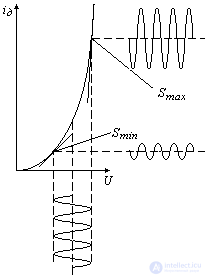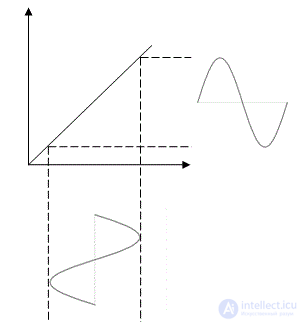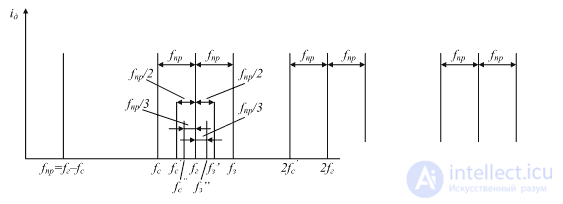Lecture
As we already considered earlier, in order to transfer the frequency of the received signal to the intermediate frequency, it is necessary to multiply the input signal by the sinusoidal voltage of the local oscillator (local oscillator). Devices that multiply two analog signals in radio receiving and radio transmitting devices are called mixers. Typically, the operation of multiplying two analog signals is due to the current-voltage characteristics of the nonlinear element. An example of the current-voltage characteristic of a nonlinear element is shown in Figure 1.

Figure 1 Multiplication of two analog signals due to the current-voltage characteristic of a nonlinear element
In real mixers, the amplitude of the local oscillator signal (local oscillator) is many times greater than the amplitude of the input signal. Therefore, the dynamic resistance (or transmission coefficient) of a non-linear element can be considered as a function of the local oscillator voltage. The transfer coefficient of a nonlinear element is determined by the formula:
 ,
,
therefore, the steepness can be considered as a derivative of the current-voltage characteristic of the nonlinear element. Then the voltage at the output of the mixer will be written as follows:

This formula shows that the described change in the mode of operation of a nonlinear element under the action of the local oscillator voltage is equivalent to multiplying the input signal by this voltage. If the current-voltage characteristic is a quadratic dependence of the current on voltage, then the derivative of it will be a linear function, in which case the slope of the nonlinear element will linearly depend on the heterodyne voltage, which means that non-linear distortion of the useful signal will not appear in the mixer.
Now we determine the transfer coefficient of the mixer (frequency converter). To do this, we use the dependence of the slope of a nonlinear element with a quadratic characteristic of the input voltage. The plot of the slope versus input voltage for a nonlinear element with a quadratic characteristic is shown in Figure 2.

Figure 2. Graph of the slope versus input voltage for a non-linear element with a quadratic characteristic
Unfortunately, in addition to the described useful transformation, additional components of the spectrum will be present at the output of the nonlinear element. First of all, it is the voltage of the local oscillator itself and its harmonics. After all, the nonlinear element has a static transfer coefficient. The same can be said for the input signal. In the case of a quadratic characteristic of a nonlinear element, its output will contain the voltage of the first and second harmonics of both the local oscillator and the input signal.
When discussing the principles of operation of the superheterodyne receiver, we have already discussed that the formula is used to transfer the spectrum of the useful signal to the intermediate frequency:

However, in the situation under consideration, the harmonics of the input signal and the local oscillator are present on the nonlinear element. The intermediate frequency can be formed not only by the first harmonics, but also by higher order harmonics. As a result, this formula is modified to the following form:

As a result, additional side reception channels are formed at the receiver. Where are these channels and the mechanism of their occurrence is illustrated in Figure 2.

Figure 2. The mechanism of the formation of side channels due to the products of nonlinearity of the second and third orders
The closest side channel is the channel f with ', separated by half the intermediate frequency. It is formed by multiplying its second harmonic and the second harmonic of the local oscillator. The frequency difference between them exactly corresponds to the intermediate frequency. As a result of the conversion, the signal of this channel passes to the output of the intermediate frequency filter without attenuation. The appearance of this side channel results in a tightening of the requirements for the radio frequency filter.
Symmetric mixer circuits, such as balanced and ring mixers, are used to combat this side reception channel. In addition, the signal level of the local oscillator plays a significant role. As the level of the heterodyne signal increases, the harmonic level of the received signal decreases. This is due to the fact that the nonlinear element actually goes into a key mode of operation.
Similarly, a side channel is formed by multiplying the third harmonic of the side channel f with "and the local oscillator. Usually, the level of third-order conversion products is higher than the level of second-order conversion products in the mixer, but this side channel is further away from the useful signal (2 / 3 f bee), and, therefore, it can be more easily suppressed using a bandpass filter of the preselector.
When designing a mixer, the number of considered harmonics of the signal and the local oscillator depends on the type of the current-voltage characteristic of the nonlinear element and the waveform of the local oscillator. The smallest number of harmonics, and, consequently, the smallest number of side channels have mixers built on nonlinear elements with quadratic current-voltage characteristics.
Recently, frequency converters with a rectangular shape of a heterodyne voltage have become widely used. At the same time, the active elements of the mixer (diodes or transistors) work practically in the key mode. At the same time, both in the open and in the closed state, they are almost linear resistance. As a result, the harmonics of the useful signal are practically not formed. Nonlinear properties of active elements appear only when the operation mode is switched, and the shorter this interval is, the better. As a consequence, the heterodyne harmonics have nothing to interact with.
To suppress unwanted spectrum components, band-pass filters are applied, tuned to the frequency of the working channel. In addition, in some schemes of mixers, various methods of compensation of voltages and currents of the local oscillator and signal are used. The most common in superheterodyne receivers received mixers for diodes and transistors. Let's start studying the operation of frequency converters with the simplest circuit - diode mixer
Comments
To leave a comment
Devices for the reception and processing of radio signals, Transmission, reception and processing of signals
Terms: Devices for the reception and processing of radio signals, Transmission, reception and processing of signals